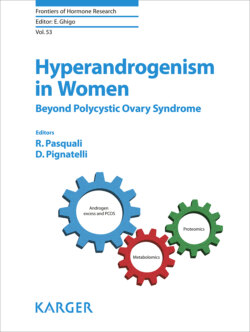Читать книгу Hyperandrogenism in Women - Группа авторов - Страница 34
Androgen Excess and Body Composition: Clinical Studies
ОглавлениеThree scenarios can be considered when describing the effect of androgen excess on body composition: in women, FtoM and PCOS; in both men and women, doping.
FtoM is the most common gender dysphoria; in this condition, a person with a female gender at birth has a male identity. It has a prevalence of 1:30,400 females, which is one third when compared to the prevalence of the MtoF transsexualism (1:11,900 males), based on the Netherlands and Belgium data [89]. Medical management is based on T administration; the following effects on body composition have been consistently reported: increase in body weight and muscle mass; quick depletion of SAT, with slower accumulation of VAT occurring in 1–3 years. Interestingly morphological changes include enlarged ovaries with a polycystic morphology [30, 89–91].
PCOS is the most common ovarian disorder associated with androgen excess in women. According to Rotterdam criteria, it can be diagnosed when 2 criteria are found between chronic oligo/anovulation, clinical or biochemical hyperandrogenism and polycystic ovaries on US, after excluding other aetiologies such as congenital adrenal hyperplasia, androgen-secreting tumours, Cushing syndrome, thyroid dysfunction, and hyperprolactinaemia; based on the combination of criteria, 4 phenotypes can be further classified [92]. Clinical series reported an association between PCOS and being overweight or obese; obesity is associated with insulin resistance; insulin has been shown to increase androgen synthesis by ovaries acting synergistically with LH and by adrenal glands with adrenocorticotropin (androgens further boosts VAT gain [93–95]. Other authors reported an increased androgens production by theca cells even when isolated in culture. The reciprocal association between insulin resistance and hyperandrogenism/ovulatory dysfunction are supported by the following evidence: metformin and bariatric surgery induce insulin sensitizing and weight loss, which are usually associated with decreased Ferriman-Gallwey score, androgen levels and in some patients to the resolution of PCOS; flutamide (a pure anti-androgen indicated for hirsutism) is associated with decreased VAT and insulin resistance [96].
Doping is a technique or the use of substances to improve exercise performance and/or body image of an athlete illegally. The most common drugs are androgens that exert their effect on both of the aspects mentioned above; this explains the reason behind their wide diffusion reported in almost 10% of adult gym users, 40% of body builders and 70% of power lifters. A randomized trial evaluated the effects of supraphysiological doses of exogenous testosterone among 43 healthy young men: those given T had greater increases in muscle size in their arms and legs and in strength in the bench-press and squatting exercises than those given placebo, independently from training [97]. It is worth noting that T exerts its effect on all types of muscular fibres, including the heart: chronic exposure to doping is associated with concentric cardiac hypertrophy, dilated cardiomyopathy, fibrosis, and increased risk of acute myocardial infarction and fatal ventricular arrhythmias [98].
